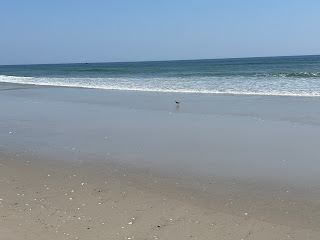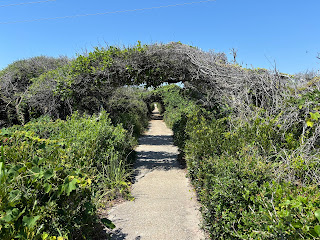The biennial family beach trip to the Outer Banks of North Carolina has become weighted down by its own history in some respects. There are comforting traditions that go back many years, and there are other things that occur with annoying regularity. My wife’s entire family has been doing this since before we all had children, and now most of our children are grown and off to college. But the show must go on.
One thing that must ALWAYS happen each time we come to this place is this: While my spouse and in-laws are getting drunk at 10am on the beach, I escape to a place of shadeless abandon at Pea Island Wildlife Refuge. Insofar as I take refuge here once every two years, I suppose that ranks me among the wildlife, though it seems a little less wild to be here than to be day-drinking and swimming in the waves. I do find great comfort here in a place where the sand and the sun and the waves are my only companions—aside from the literal wildlife. And my new interest in birds has opened my eyes to more of the wildlife that’s on display here.
There are few places along the East Coast where you can have the ocean all to yourself. This is one of them. For miles and miles.
Rangers riding in “gators” will occasionally drive down the beach to make sure no one is disturbing the nests of plovers and other seabirds. With the enormous heatwave, it was surprising how much cooler the temps were on top of the dunes or to the west of them, away from the ocean and rising sun.
Alas, poor elegant jellyfish. How did such a lot befall you? Of course, you’re short-lived creatures, as things of great beauty must often be. Why must the beautiful perish? I ask it too often.
This elusive and equally elegant fellow was quite lanky and camera shy. My Merlin bird app could not seem to identify him, but when he takes flight, you see that he’s a beautiful mix of gray and white with a long, formal-looking tail and long wings. Very erect and proper-looking. I’ve seen these birds all along the island, but they don’t appear in any of the island’s wildlife guides.
As e.e. cummings said:
whatever we lose
(like a you or a me)
it’s always ourselves
we find at the sea
And birds. You find them, too. I find myself a little better among the trees, for I’m a woodland creature. But there is nothing like the ocean—its grandeur, its mystery, its smell and sound and sight.
See the dark protuberance in the water? That’s the boiler of The Oriental, a Union supply ship that sank here in 1862. It adds just a touch of eeriness to the place.
At Pea Island, there’s a visitor center where I typically buy a T-shirt (different style each year). There’s the beach on one side and the sound—or bay—on the other. The bay walk was painfully hot, but it passes through a nice arbor of live oaks.
You can’t tell from any of these photos, but this is a red-winged blackbird—one of the common birds back home, which I did not expect to find here at the coast. He flew right at me, but I didn’t flinch because we were having a moment. Then he perched on this dead treetop and spoke for about three minutes while I listened. Then he flew directly at me again, and again I did not dart away, though his red epaulets made him look fierce as he approached in rapid flight. Then he flew off over the marshy pond.
I wish his red patch and yellow stripe were visible in these photos.
The bay side has turtle ponds. Moss grows on the backs of some of these aged fellows.
I also saw a sea otter, but didn’t get a pic in time.
And this fellow? Amazing creature! These sand crabs have eyes on top of their heads so that they can see in every direction at once, and they move in a scuttling walk—backwards, forwards, sideways. I’m a little jealous.






















